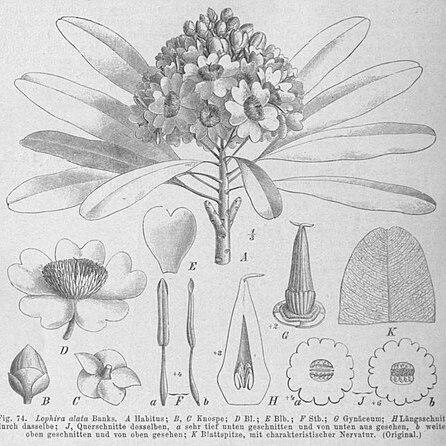Coarsely branched tree up to 9–16 m tall with clean bole up to 7.5 m tall; bark corky, grey, very coarsely flaking in small pieces; flakes brick-red to yellow beneath, brittle; slash bright yellow cork layer above, crimson-red granular beneath.. Leaves red when young, oblong-lanceolate, 11–45 cm long, 2–9 cm wide, rounded to retuse at the apex, cuneate and often asymmetrical at base, entire, glabrous; lateral veins very numerous together with midrib prominent on both surfaces; petiole 2–6 cm long; stipules linear-lanceolate, 3–5 mm long, 0.7 mm wide, deciduous.. Panicles profuse, terminal, pyramidal, lax, 15–20 cm long; axes angular, striate, glabrous.. Flowers white, scented; pedicels 1–1.5 cm long, jointed near apex, glabrous.. Sepals unequal, glabrous; 2 outer ovate-acuminate, 7–8 mm long, 4–5 mm wide, acute at apex; inner 3 broadly ovate, 6 mm long, 5 mm wide, obtuse at apex.. Petals obcordate, 1.7 cm long, 1.3 cm wide, glabrous.. Stamens with filaments white, 4–6 mm long and anthers orange, 4–5 mm long.. Ovary white, conical, 8 mm long, 3 mm wide; stigmas 1–2 mm long; ovules 8–16.. Fruits conical, 3 cm long, 1 cm wide, glabrous with unequal wing-like enlarged sepals, one 8–10 cm long, 2–2.5 cm wide and the other 2.5–5 cm long, 0.6–1 cm wide.. Seed 1, ovoid, 1.6 cm long, 8 mm wide.. Fig. 8 (p. 54).
More
A medium sized tree up to 15 m tall. It is often stunted and twisted due to bush fires. The tree in flower is attractive. It has large strap like leaves. They grow in tufts at the ends of scarred twisted branches. The leaves 15-45 cm long by 2.5-7.5 cm wide. The flowers are in open panicles of white flowers. The flowers are 2.5-3.5 cm across. The panicles are 15 cm long. The fruit contain one long seed. The seeds are winged and 7 cm by 3 cm. The wings are often crimson. The nut inside is beaked and 2.5 cm long.

